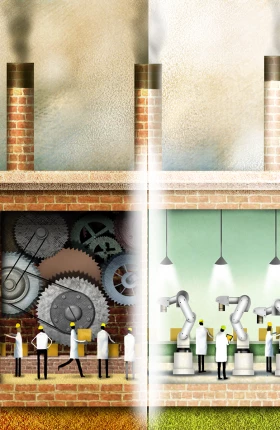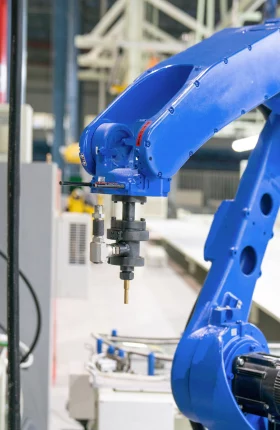For the past few decades, the scramble for competitive advantage in manufacturing has largely revolved around finding new and abundant sources of low-cost labor. But with wages rising rapidly in China and other emerging markets, manufacturers worldwide are under intensifying pressure to gain advantage the old-fashioned way—by improving their productivity.
Technological development is likely to be the catalyst for the next wave of manufacturing productivity gains. This development, which some refer to as Industry 4.0, is characterized by cyber-physical systems (CPS) and dynamic data processes that use massive amounts of data to drive smart machines. A confluence of forces—falling prices and rising performance of enabling hardware and software, the digitization of industry, increasing connectivity, and mounting pressure on manufacturers to be more flexible and eco-friendly—is likely to accelerate adoption of the next generation of advanced manufacturing technologies. In the near future, they may transform the economics of global production in many industries.
The term “advanced manufacturing” has been around for decades and means many things to many people. We define advanced-manufacturing technologies as a set of highly flexible, data-enabled, and cost-efficient manufacturing processes. These tools offer a range of benefits that, taken together, could redefine the economics of global-manufacturing competitiveness in a number of industries. In fact, leading-edge manufacturers, such as Ford and General Electric, are already using some of the most advanced tools to make high-precision components.
Our research has found that a large majority of American-based manufacturing executives are beginning to explore advanced manufacturing. In our third annual survey of U.S.-based manufacturing executives at companies with sales of at least $1 billion, 72 percent of respondents said that they will invest in additional automation or advanced-manufacturing technologies in the next five years. Only 10 percent said that they are unlikely to do so. Roughly three-quarters of the executives we surveyed said that they expect advanced manufacturing to improve productivity and create more localized production. Fifty-six percent of respondents predicted that lower automation costs will improve their competitiveness against products made in low-cost countries.
Advanced-manufacturing technologies can boost productivity in a number of ways. They dramatically increase flexibility by making it feasible for manufacturers in some industries to offer customers the option to “have it your way.” Manufacturers can also make products in small batches for specific customers, adjust production lines in response to design changes, and even speed time to market by generating prototypes very quickly.
Advanced-manufacturing technologies can boost innovation, too, by allowing manufacturers to create new kinds of products that can’t be made cost effectively with conventional processes. They also permit manufacturers to produce high-quality goods made to buyers’ exact specifications. What’s more, these processes are good for the environment because they often consume fewer raw materials and generate less scrap. They improve safety as well, by exposing workers to fewer hazardous materials.
As of now, we believe that the following five technological tools have the greatest potential to influence the manufacturing landscape and improve productivity in the years ahead.
Autonomous Robots. A new generation of automation systems links industrial robots with control systems through information technology. New robotic and automation systems equipped with sensors and standardized interfaces are beginning to complement—and, in some cases, eliminate—human labor in many processes. This could enable manufacturers to cost-effectively produce items at smaller scale and to improve their ability to enhance quality. (See “ The Rise of Robotics ,” BCG article, August 2014.)
Integrated Computational Materials Engineering (ICME). By creating computer models of products and simulating their properties before they are fabricated—rather than building and testing multiple physical prototypes—engineers and designers can develop products better, faster, and cheaper.
Digital Manufacturing. Virtualization technology can be used to generate complete digital factories that simulate the entire production process. Among other things, digital simulation can help engineers save time and money by optimizing the layout of a factory, identifying and automatically correcting flaws in each step of the production process, and modeling product quality and output. Entire assembly lines can be replicated in different locations at relatively low cost.
The Industrial Internet and Flexible Automation. Manufacturing hardware can be linked together so that machines are able to communicate with one another and automatically adjust production based on data generated by sensors. They can “see” into the supply chain.
Additive Manufacturing. Commonly known as 3-D printing, additive-manufacturing processes create three-dimensional objects based on digital models by successively depositing thin layers of materials. Such processes are already starting to be used for making prototypes in some industries, including aerospace, automotive parts, and basic consumer items. In the future, these processes are expected to be used to build small batches of new kinds of products made out of one solid piece of material, such as hollow spheres that have no seams. (See “ 3D Printing Will Change the Game ,” BCG article, September 2013.)
These technologies are not widely deployed today and won’t have a significant impact in the very short term. They are also unlikely to replace labor as the most important cost factor in many industries over the next five to ten years. The material science of 3-D printing is still evolving, for example, with significant advances required to make it viable and cost effective for many substrates and particularly for end-use parts. But, to varying degrees, each of these advanced-manufacturing tools is already being used by leading-edge manufacturers with impressive results. And they are expected to eventually become important factors in industry.
While predictions of a new technological leap in manufacturing have been circulating for quite some time, the move is now getting closer to reality for several reasons. One is a trend that BCG has been following for the past three years: the shifting economics of global manufacturing. (See The Shifting Economics of Global Manufacturing: How Cost Competitiveness Is Changing Worldwide , BCG report, August 2014.) For example, when Chinese labor costs were around one-twentieth of those in the U.S. a little more than a decade ago, it was a no-brainer to locate production in China rather than invest in expensive state-of-the-art capacity in the U.S. Today—after accounting for productivity, logistics, and other costs—the cost gap between China and the U.S. has nearly disappeared for many products. Similarly, several Eastern European economies have lost much of their cost competitiveness compared with the UK, and Brazil is now estimated to be more expensive than much of Western Europe. (See Made in America, Again: Why Manufacturing Will Return to the U.S ., BCG Focus, August 2011.) Germany’s strategy to improve its competitiveness through Industry 4.0 will be explored in an upcoming BCG publication.
A number of other trends are also having an impact. Rapid advances in information technology, sensors, and nanomaterials are dramatically lowering the costs of leading-edge manufacturing processes and improving their performance. Slowly but surely, digitization has begun to permeate every aspect of the production process, from engineering to management of the supply chain to the factory floor—making production systems more intelligent and highly networked. At the same time, companies are under mounting pressure to improve their productivity and become more responsive to shifting customer needs.
Advanced-manufacturing technologies could potentially help address a number of these needs. New processes boost productivity and responsiveness to the market by making it possible for manufacturers to quickly and easily modify designs and reconfigure production lines according to customer demands. As a result, manufacturers can generate a greater diversity of products using a similar set of processes. Factories of the future will combine the efficiency of mass production with custom manufacturing: each machine will be capable of producing a variety of bespoke goods that are made specifically for the needs of customers—something that is difficult, and often prohibitively expensive, to do using conventional manufacturing processes. They could even make one-off objects without additional capital expenditures.
Because information technology can enable networks of robots to communicate with one another, entire production systems and supply chains can also become more efficient. Robots can relay data on a problem in one part of a production line to robots in other parts of the line, so they can adjust. Furthermore, by accessing supplier networks through the Industrial Internet, robots can automatically adjust production flows in line with updated delivery schedules for parts and materials, thereby reducing waste and inventory costs.
Several leading manufacturers are already demonstrating the potential of some of these advanced processes. Ford Motor, for example, is using ICME to reduce the time and cost of developing aluminum castings for engines. The conventional method is to design an engine block on a computer, build a physical prototype, test it, and then tweak the design, rebuild the prototype, and retest it—again and again—until the product is ready to be manufactured. Using an ICME process, digital models of castings are tested virtually, and a prototype is built only after engineers are convinced that they have created the best design. Ford invested $15 million over five years in this ICME experiment, which involved 15 of its own engineers and 10 university researchers. So far, the company estimates that it has generated cost savings of more than $120 million—a 700 percent return on investment—while development times have been cut by 15 to 25 percent.
General Electric is successfully using additive-manufacturing processes to build fuel nozzles for LEAP turbofan engines, which are being developed for next-generation single-aisle aircraft. In the additive-manufacturing process, the nozzles are built by a computer-guided laser from layers of metal powder. “The new nozzle is 25 percent lighter than the machined component and is as much as five times more durable than the current nozzle made from 20 different parts,” GE reports. According to a company press release, GE will spend $32 million to build a new research-and-education center focused on additive technologies in Pennsylvania.
We believe that as advanced manufacturing processes improve, become more practical, and are disseminated through the supply chain, many more manufacturers will realize significant gains in cost and productivity. According to analysis by BCG, a combination of these tools could help reduce production costs (excluding raw materials) by 20 to 40 percent.
The next technological revolution in manufacturing will take time to fully unfold, but the early stages have already begun. Over the next year, we at BCG will begin to share with you our in-depth perspectives on several of these technologies and explore their probable impact on manufacturing industries.
Manufacturers reassessing their global production networks in light of dramatic shifts in costs such as labor and energy must embrace advanced-manufacturing technologies. It is too early to grasp the comprehensive impact of these tools and processes or to see how they will evolve. But it is clear that they will radically redefine the dynamics of global competition in many industries. Advanced-manufacturing technologies will enable companies to manufacture goods faster, better, and cheaper—and lead to quantum leaps in productivity






